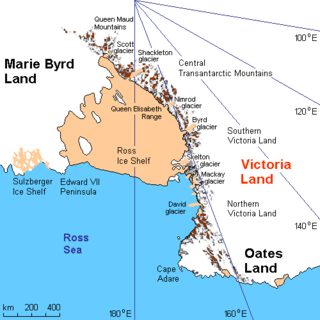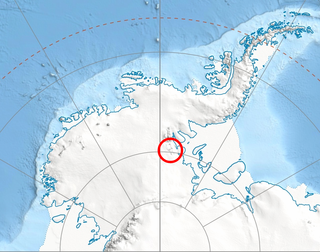Related Research Articles
The Reedy Glacier is a major glacier in Antarctica, over 100 nautical miles long and 6 to 12 nautical miles wide, descending from the polar plateau to the Ross Ice Shelf between the Michigan Plateau and Wisconsin Range in the Transantarctic Mountains. It marks the limits of the Queen Maud Mountains on the west and the Horlick Mountains on the east.

The Sentinel Range is a major mountain range situated northward of Minnesota Glacier and forming the northern half of the Ellsworth Mountains in Antarctica. The range trends NNW-SSE for about 185 km (115 mi) and is 24 to 48 km wide. Many peaks rise over 4,000 m (13,100 ft) and Vinson Massif (4892 m) in the southern part of the range is the highest elevation on the continent.
The Amundsen Glacier is a major Antarctic glacier, about 7 to 11 km wide and 150 km (80 nmi) long. It originates on the Antarctic Plateau where it drains the area to the south and west of Nilsen Plateau, then descends through the Queen Maud Mountains to enter the Ross Ice Shelf just west of the MacDonald Nunataks.

The Branscomb Glacier is an Antarctic glacier, 11 nautical miles long, flowing west from the north-west side of Vinson Massif into Nimitz Glacier, in the Sentinel Range of the Ellsworth Mountains. Its upper course receives ice influx from both Goodge Col and Jacobsen Valley, while the tributary Roché Glacier joins Branscomb Glacier just northwest of Príncipe de Asturias Peak. Branscomb Glacier has been the focus of scientific research expeditions aimed at studying glaciology, ice dynamics, and climate change in Antarctica.
Foundation Ice Stream is a major ice stream in the Pensacola Mountains of Antarctica. The ice stream drains northward for 150 nautical miles along the west side of the Patuxent Range and the Neptune Range to enter the Ronne Ice Shelf westward of Dufek Massif.

Mount Ulmer is a prominent peak situated 2 miles north of Mount Washburn in Gromshin Heights on the east side of northern Sentinel Range in Ellsworth Mountains, Antarctica. It surmounts the head of Vicha Glacier to the east and Newcomer Glacier to the west.

The Scott Glacier is a major glacier, 120 nautical miles long, that drains the East Antarctic Ice Sheet through the Queen Maud Mountains to the Ross Ice Shelf. The Scott Glacier is one of a series of major glaciers flowing across the Transantarctic Mountains, with the Amundsen Glacier to the west and the Leverett and Reedy glaciers to the east.

The Dufek Massif is a rugged, largely snow-covered massif 27 nautical miles long, standing west of the Forrestal Range in the northern part of the Pensacola Mountains, Antarctica.

Muir Peak is a conspicuous rock peak near the middle of Frazier Ridge in the Founders Peaks, Heritage Range. It was mapped by the United States Geological Survey (USGS) from surveys and U.S. Navy air photos from 1961 to 1966. It was named by the Advisory Committee on Antarctic Names (US-ACAN) for Hugh M. Muir, a United States Antarctic Research Program (USARP) auroral scientist and member of the winter party at the Plateau Station in 1966.
The Gothic Mountains is a group of mountains, 20 nautical miles long, in the Queen Maud Mountains of Antarctica, located west of Watson Escarpment and bounded by Scott Glacier, Albanus Glacier, and Griffith Glacier.

Webster Glacier is a glacier in the Founders Peaks of the Heritage Range, flowing generally north between Frazier Ridge and Pipe Peak to enter Minnesota Glacier. Mapped by United States Geological Survey (USGS) from surveys and U.S. Navy air photos, 1961–66. Named by Advisory Committee on Antarctic Names (US-ACAN) for Charles W. Webster, United States Antarctic Research Program (USARP) meteorologist and member of the winter party at Wilkes Station in 1963.
Founders Escarpment is a prominent escarpment located west of the Founders Peaks in the Heritage Range of Antarctica, extending from Minnesota Glacier to Splettstoesser Glacier. It was named after the nearby Founders Peaks by the University of Minnesota Geological Party, 1963–64.
The Founders Peaks are a cluster of sharp peaks and ridges located just east of Founders Escarpment and between Minnesota Glacier and Gowan Glacier, in the Heritage Range of the Ellsworth Mountains in Antarctica. The peaks were mapped by the United States Geological Survey from surveys and U.S. Navy air photos, 1961–66. The name was applied by the Advisory Committee on Antarctic Names is association with the name Heritage Range.
Frazier Ridge is a sharp ridge on the west side of Webster Glacier, extending north from Founders Escarpment to Minnesota Glacier, in the Heritage Range of Antarctica. It was named by the University of Minnesota geological party, 1963–64, for Sergeant Herbert J. Frazier, a radioman with the 62nd Transportation Detachment who was of assistance to the party.
Matney Peak is a mostly ice-free peak, 1,810 metres (5,940 ft) high, near the middle of the line of peaks on the east side of Webster Glacier in the Heritage Range of the Ellsworth Mountains, Antarctica. It was mapped by the United States Geological Survey from surveys and U.S. Navy air photos, 1961–1966, and was named by the Advisory Committee on Antarctic Names for Chief Aviation Boatswain's Mate William R. Matney of the U.S. Navy who contributed significantly to improving fuel operations in Antarctica and, for a portion of Operation Deep Freeze 1966, acted as fuels officer.

Splettstoesser Glacier is a glacier, 35 nautical miles long, draining from the plateau just south of Founders Escarpment and flowing east-northeast through the Heritage Range to the south of Founders Peaks and Anderson Massif to enter the Minnesota Glacier. Named by the University of Minnesota Ellsworth Mountains Party which explored the area in 1961-62 for John F. Splettstoesser, geologist with that party.

Brook Glacier is a glacier that flows westward between Mount Strybing, Mount Allen and Krusha Peak on the west side of Owen Ridge in southern Sentinel Range, Ellsworth Mountains in Antarctica, and joins Bender Glacier east of Chaplin Peak. It was named by the Advisory Committee on Antarctic Names (2006) after Edward J. Brook, Professor of Geosciences, Oregon State University; U.S. Antarctic Project investigator of Antarctic paleoclimate in numerous field seasons from 1988; Chair, U.S. National Ice Core Working Group for use of Antarctic ice cores for research purposes, 2004–05.
The Rawson Mountains lie within the Queen Maud Mountains to the southeast of the Ross Ice Shelf in Antarctica. They are a crescent-shaped range of tabular, ice-covered mountains including Fuller Dome, Mount Wyatt and Mount Verlautz, standing southeast of Nilsen Plateau and extending southeast for 18 nautical miles to the west side of Scott Glacier.

Cairns Glacier is a glacier on the west slope of Vinson Massif, Sentinel Range in Antarctica, situated between Branscomb Glacier and Tulaczyk Glacier. It flows along the northwest side of Brichebor Peak southwestwards, and leaving the range together with Tulaczyk Glacier joins Nimitz Glacier southeast of Klenova Peak.

Schmidt Glacier is a glacier, 20 nautical miles long, in the Pioneer Heights of the Heritage Range, Ellsworth Mountains in Antarctica. The glacier originates near Hall Peak and drains north along the west side of Thompson Escarpment and Gross Hills to coalesce with the lower part of Splettstoesser Glacier, north of Mount Virginia. It was named by the University of Minnesota Ellsworth Mountains Party, 1961–62, for Paul G. Schmidt, geologist with the party.
References
 This article incorporates public domain material from "Pipe Peak". Geographic Names Information System . United States Geological Survey.
This article incorporates public domain material from "Pipe Peak". Geographic Names Information System . United States Geological Survey.
